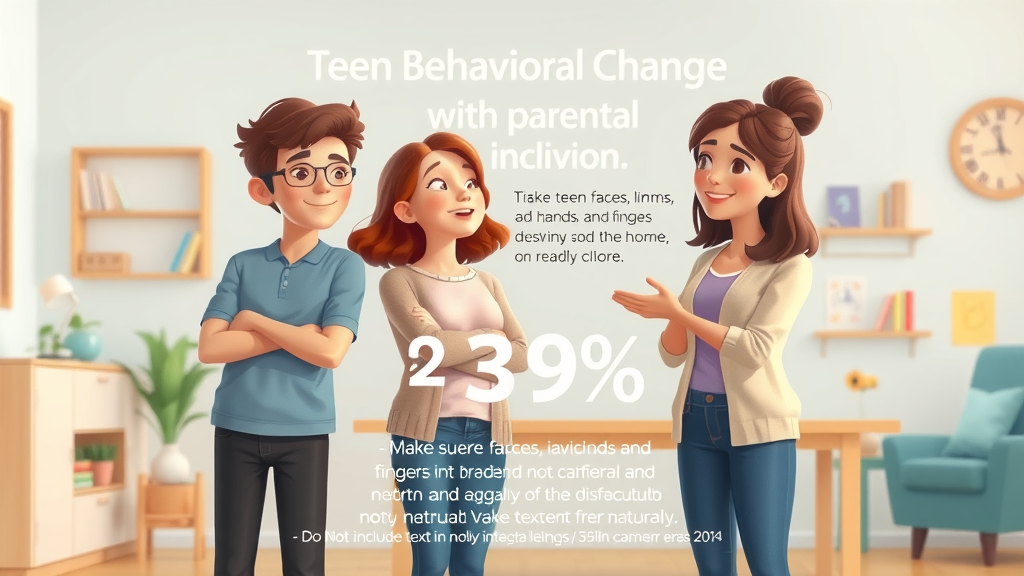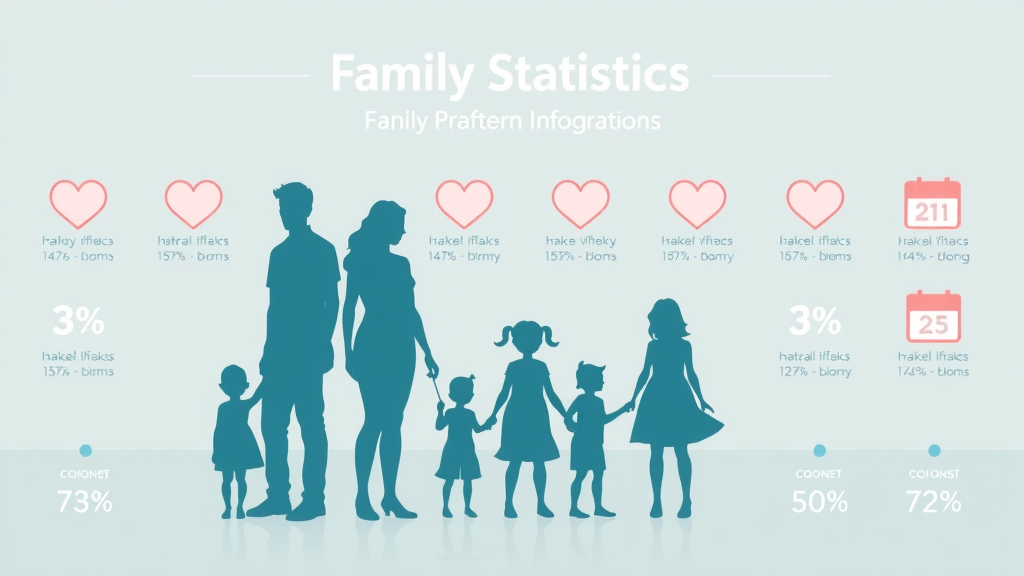Did you know that teens whose parents actively participate in behavioral interventions are up to 30% more likely to show lasting positive behavioral change, according to recent studies? This statistic might surprise many, considering how challenging the teenage years can be. Yet, it shines a light on the transformative power of parental involvement and properly applied behavioral intervention strategies at home—especially when positive reinforcement is the focus. In this comprehensive guide, you'll learn why positive reinforcement is a cornerstone of behavioral interventions for teens and how you, as a parent or caregiver, can foster healthier habits, stronger coping skills, and improved family relationships starting today.
A Surprising Statistic: The Power of Behavioral Interventions for Teens
Statistics reveal that consistent parental engagement in behavioral interventions for teens can decrease negative behaviors and improve school performance dramatically. In fact, studies show that teens involved in structured behavioral therapy with positive reinforcement see improvements not just in their behavior, but also in their emotional resilience and mental health. This is crucial during adolescence—a time marked by intense change, social pressures, and the increased risk of developing mental health disorders such as anxiety, depression, or even substance abuse.
By combining effective behavioral interventions like cognitive behavioral therapy, family therapy, and structured home reward systems, parents help teens learn valuable coping skills and manage their emotions more effectively. These evidence-based methods don’t just tackle surface-level issues; they address underlying negative thought patterns which can spiral into more severe mental health conditions. Let’s take a closer look at how embracing positive reinforcement brings measurable growth and emotional well-being to your teen and your family.

What You'll Learn in This Guide to Behavioral Interventions for Teens
- What behavioral interventions for teens are and why they're important for mental health
- How positive reinforcement works as a behavioral therapy technique
- Step-by-step strategies to implement positive reinforcement at home
- Real-life examples from mental health professionals
- Common pitfalls and how to avoid them
- Ways to support teens with various behavioral or health conditions
Understanding Behavioral Interventions for Teens: Mental Health Foundations
Behavioral interventions for teens refer to a set of evidence-based techniques designed to change negative or unhelpful behavior patterns. These interventions often draw from principles found in behavioral therapy and more specifically, cognitive behavioral therapy (CBT). The goal? To help teens develop lasting coping skills in response to environmental triggers, negative thoughts, or stressful emotions. By addressing the links between thoughts, feelings, and behaviors, these interventions empower teens to better manage their emotions, improve social skills, and adapt more positively to life’s challenges.
Behavioral interventions are particularly important for teens facing common mental health conditions like anxiety, depression, eating disorders, or conduct disorders. These approaches can even be tailored to support teens dealing with substance abuse or other health conditions affecting behavior. Importantly, integrating family therapy can dramatically improve outcomes. When families engage together—refining communication and supporting new behaviors—the success rate of behavioral interventions for teens multiplies, fostering a more positive and connected home environment.

Why Focus on Positive Reinforcement in Behavioral Interventions for Teens?
Positive reinforcement stands as a core behavioral intervention for teens and is distinct from traditional punishment models. While punishment seeks to reduce unwanted behavior by imposing consequences, positive reinforcement encourages the repetition of desirable actions by offering meaningful rewards. Research consistently underscores the lasting impact of positive reinforcement: teens are more likely to repeat behaviors that elicit praise, tangible rewards, or increased privileges. Unlike punitive approaches, positive reinforcement nurtures trust and self-esteem, promoting psychological safety as teens learn and grow.
Importantly, studies highlight that positive reinforcement not only motivates good behavior but can also help teens change negative thought patterns and improve their overall mental health. By focusing on rewarding progress and effort, parents foster resilience and adaptive coping skills—key defenses against mental health disorders. This shift away from punishment helps reduce stress and defiance. Over time, consistently reinforcing positive behavior leads to long-term emotional regulation and a stronger parent-teen relationship.
Types of Behavioral Interventions for Teens and Their Effectiveness
There are several types of behavioral interventions for teens that parents and professionals can use to address behavioral issues and mental health conditions. Cognitive behavioral interventions form the backbone of many therapy sessions, teaching teens how to identify and restructure unhelpful thought patterns. Token economies—systems that allow teens to earn tokens or points for desired actions—are often used at home or school to improve motivation, school attendance, and daily routines. These reward-based charts make progress visible and tangible, especially for teens with ADHD or similar challenges.
Other strategies include structured home programs, which outline clear expectations, routines, and consequences, as well as regular family therapy sessions to strengthen communication. Notably, early intervention is crucial: addressing issues when they first arise gives teens the support they need before negative thought patterns or behaviors become deeply entrenched. The combination of home-based and professionally guided interventions yields the best results, particularly when parents, therapists, and teachers work in partnership.
| Intervention Type | Approach | Best For | Supporting Therapy |
|---|---|---|---|
| Cognitive Behavioral | Thought/behavior patterns | Anxiety, depression, negative thought cycles | Yes |
| Token Economy | Reward system | Motivation, school attendance, chores | Can support |
| Family Therapy | Family communication | Conflict resolution, overall family dynamics | Essential |
| Early Intervention | Proactive strategies | Prevent escalation of behavioral issues | Recommended |

The Science Behind Behavioral Interventions for Teens: Cognitive Behavioral and Therapy Session Approaches
Cognitive behavioral therapy (CBT) provides the scientific foundation for many behavioral interventions for teens. At its core, CBT teaches that thoughts, feelings, and behaviors are interconnected—and by identifying unhelpful thought patterns, teens can shift their behaviors toward healthier outcomes. These skills are often taught during individualized therapy sessions, where a mental health professional guides the teen through practical exercises and reflection. Teens learn to break cycles of negative thinking, replace them with constructive self-talk, and build emotional resilience for real-life challenges.
When families combine professional behavioral therapy with ongoing support at home, teens receive the consistent messages and encouragement they need. This integrative approach ensures that strategies learned in therapy sessions—like developing adaptive coping skills, managing emotions, and goal-setting—are reinforced through daily routines and family support. Whether a teen is coping with anxiety, depression, or disruptive behavioral issues, the blend of professional and familial reinforcement produces measurable gains in their mental health and well-being.

Step-by-Step: Implementing Positive Reinforcement as a Behavioral Intervention for Teens at Home
Putting positive reinforcement into practice for behavioral interventions at home doesn’t need to be complex—but it does require planning, patience, and consistency. Start by identifying the specific behaviors you wish to encourage, such as completing homework, practicing kind communication, or attending therapy sessions on time. Next, select positive reinforcers tailored to your teen’s interests: this could range from verbal praise and extra screen time to a special outing or earned privileges. The key is to make the rewards both meaningful and appropriate for your teen’s age and personality.
Create clear expectations and routines so your teen understands what is needed to earn positive reinforcement. Provide feedback as soon as you observe the desired behavior, ensuring your praise is specific and genuine (“I noticed you finished your project before dinner—great job organizing your time!”). Track progress together, using charts or logs for extra motivation, and regularly review which reinforcers work best. Adjust techniques as needed—teens grow, and so do their interests and motivators! This approach empowers your teen, boosts their confidence, and builds open, positive communication in your home.
- Step 1: Define the behavior you want to encourage
- Step 2: Select age-appropriate and meaningful rewards
- Step 3: Communicate expectations clearly and positively
- Step 4: Provide immediate and specific positive reinforcement
- Step 5: Track behavioral changes and review results regularly

Supporting Teens with Behavioral Interventions While Addressing Mental Health Conditions
Adolescents often face complex mental health conditions that contribute to behavioral challenges. For instance, anxiety, depression, ADHD, eating disorders, and substance abuse can all affect a teen’s behavior and their ability to manage emotions. In these cases, combining behavioral interventions for teens with targeted therapy, medication (when recommended), and professional support is essential for holistic healing. Early intervention—addressing concerns as soon as they arise—increases the chances of long-term, positive change.
Mental health professionals, such as therapists and psychologists, play a pivotal role. They assess the teen’s needs, design personalized therapy sessions, and coach families through roadblocks. Parents should communicate openly with professionals, attending therapy sessions as needed and implementing strategies recommended for home. This supportive network ensures that strategies to teach new skills and change negative behaviors are reinforced in all areas of a teen’s life, making improvement far more sustainable.
Common Challenges in Behavioral Interventions for Teens—and How to Overcome Them
While behavioral interventions for teens are highly effective, parents frequently encounter obstacles such as inconsistency in reinforcement, teen resistance, or difficulty addressing ingrained negative thought patterns. Inconsistent positive reinforcement—such as rewarding sometimes but not others—can confuse teens and undermine progress. Resistance may manifest as stubbornness, withdrawal, or lack of motivation, especially in teens struggling with behavioral or mental health disorders.
To overcome these challenges, prioritize open communication, active listening, and empathy. Don’t shy away from seeking outside help; regular family therapy or meetings with a mental health professional can provide practical strategies. Remember, balancing structured behavioral therapy with the demands of school and extracurricular activities is vital for your teen’s well-being. Establish routines, set realistic expectations, and celebrate all improvements—however small. This perseverance sets the stage for your teen’s growth and builds trust within the family unit.

Real-World Success: Positive Reinforcement in Behavioral Interventions for Teens
"After a few weeks of consistently using positive reinforcement, our son's negative thought patterns improved, and school attendance increased dramatically. The change in our family dynamic was remarkable."
One notable case involves the use of a token economy for a teen diagnosed with ADHD, who faced challenges with focus and completing homework. By introducing a point-based reward chart and recognizing small wins, the teen’s motivation skyrocketed, leading to more consistent school performance. Another family found family therapy invaluable for improving communication and reducing household conflict. Through collaborative sessions, everyone gained tools to manage their emotions, and the family dynamic shifted from tense to supportive.
Cognitive behavioral techniques have also played a vital role for teens managing anxiety and depression. With guided practice in therapy sessions, these teens learned to spot and challenge negative thoughts, replacing them with constructive alternatives. Parents reinforced these skills at home, helping their teens develop stronger coping skills for everyday challenges—laying the foundation for lasting mental health and academic success.

How to Include Behavioral Interventions for Teens in Professional Mental Health Settings
Behavioral interventions for teens are not confined to the home; they form a central part of many professional mental health programs. In a formal therapy session, therapists typically begin by assessing the teen’s unique needs and setting measurable goals. Sessions may involve role-playing, teamwork exercises, or problem-solving tasks to break negative cycles. The therapist tracks progress over time—using clinical assessments, behavioral worksheets, or parent/teen feedback—and adjusts strategies as needed to ensure continuous improvement.
Incorporating family therapy alongside cognitive behavioral therapy is proven to yield the best results for many behavioral and mental health conditions. Family members learn to support the teen by practicing new communication strategies, addressing underlying conflicts, and reinforcing positive behaviors at home. This holistic approach ensures accountability and provides teens with a robust network—both at home and in the clinical setting—for sustainable behavioral change.
| Factor | Professional Setting | Home Setting |
|---|---|---|
| Structure | Formal, scheduled sessions | Informal, daily routine |
| Involvement | Mental health professionals | Parents/guardians |
| Flexibility | Guided by therapist | Adapted by parents |
| Outcome Measurement | Clinical assessment | Behavior tracking logs |
Key Takeaways: Positive Reinforcement and Behavioral Interventions for Teens
- Start early for maximum impact: early intervention is critical
- Consistency is essential for behavioral interventions for teens
- Combining home and professional efforts yields best results
- Always recognize improvements, no matter how small
People Also Ask: Behavioral Interventions for Teens
What are positive reinforcement strategies for teens?
Positive reinforcement strategies for teens include offering praise, tangible rewards, or privileges immediately following a desired behavior. Examples are giving extra screen time when chores are done, public acknowledgment for effort in school, or creating a points-based reward system. These approaches motivate teens to repeat positive actions and build self-confidence, especially when paired with clear expectations and sincere feedback.
Can behavioral interventions for teens help with anxiety and depression?
Yes, behavioral interventions—especially those rooted in cognitive behavioral therapy—can be highly effective for teens dealing with anxiety and depression. These interventions help teens recognize and change negative thought patterns, while also teaching practical coping skills to manage stress and difficult emotions. Positive reinforcement further supports recovery by encouraging engagement in healthy behaviors, fostering hope, and boosting resilience.
What role do parents play in behavioral interventions for teens?
Parents serve as powerful agents of change in behavioral interventions for teens. By consistently implementing positive reinforcement, setting healthy boundaries, and actively participating in therapy sessions when appropriate, parents create a supportive environment for growth. Their involvement models adaptive behaviors, strengthens communication, and ensures that therapeutic strategies are reinforced at home.
FAQs on Behavioral Interventions for Teens
-
How often should behavioral interventions for teens be reassessed?
Interventions should be monitored weekly and formally reassessed with a mental health professional every few months, or whenever significant changes are noticed. -
Are behavioral interventions for teens suitable for all mental health conditions?
While most teens can benefit, some severe or complex mental health conditions may require additional therapies, medication, or specialized interventions. Always consult with a mental health professional for guidance. -
How can schools support behavioral interventions for teens?
Schools can reinforce interventions by collaborating with parents and therapists, offering positive feedback, encouraging participation in health programs, and maintaining open communication with families. -
What are the first steps for parents interested in behavioral interventions for teens?
Begin by observing your teen’s challenges, consult with a mental health professional, and educate yourself about positive reinforcement and evidence-based behavioral strategies before introducing changes at home.
Conclusion: Empowering Parents with Effective Behavioral Interventions for Teens
"Positive reinforcement is not only an effective behavioral intervention for teens, but also a catalyst for lasting change in families."
Ready to Make Positive Changes? Take the First Step with Behavioral Interventions for Teens
Empower your family today by embracing positive reinforcement as a key component of behavioral interventions for teens. Start small, be consistent, and watch your teen—and your family—thrive.
 Add Row
Add Row  Add
Add 





Write A Comment